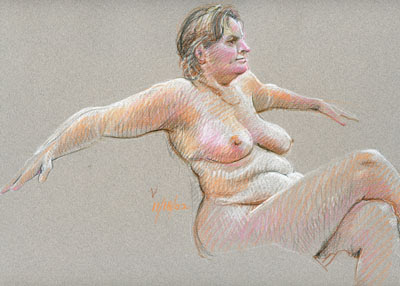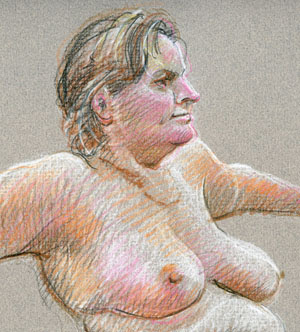I don't believe I've spoken about one other important aspect of line in the past. Altho' it is a single line, the crucial idea is the use of varying pressure to emphasize the importance of particular line segments, e.g. to signal a change in direction or to high-light important shadow areas without actually adding shadows. Aside from that, an interesting aspect of the line in this case is to put emphasis on the ends of the line especially where it intersects with another Look at the lines delineating the hair. Each line starts out strong at the forehead and temple then fades, helping us to see form in the mass of hair. You can, if you wish, add the emphasis to particular lines after the initial line is drawn or after you have finished the whole drawing. You can use the same color or one slightly darker or a bit more intense as I've done here. (As noted in the past, the added white enhances the 3 dimensional aspects of the subject.)
A third important aspect of the varied line is its contribution to variety within the drawing. Variation of line weights helps to make a drawing more interesting . The viewer's attention to these varied line weights slows his progress as he scans the work, adding to his pleasure by following your actual work in making the drawing. As you produce the drawing you teach the viewer about drawing, unity (harmony) in the drawing design and the importance of careful observation, whether in the initial work or in viewing the finished piece! Not just an artist you'll be, but a teacher!
"Repetition and variety create unity. " Virginia Wieringa
"Get to know the subject intimately... by (looking) and learning from nature." Melissa Jean
"To teach is to learn twice." Joseph Joubert







299+copy.jpg)










































